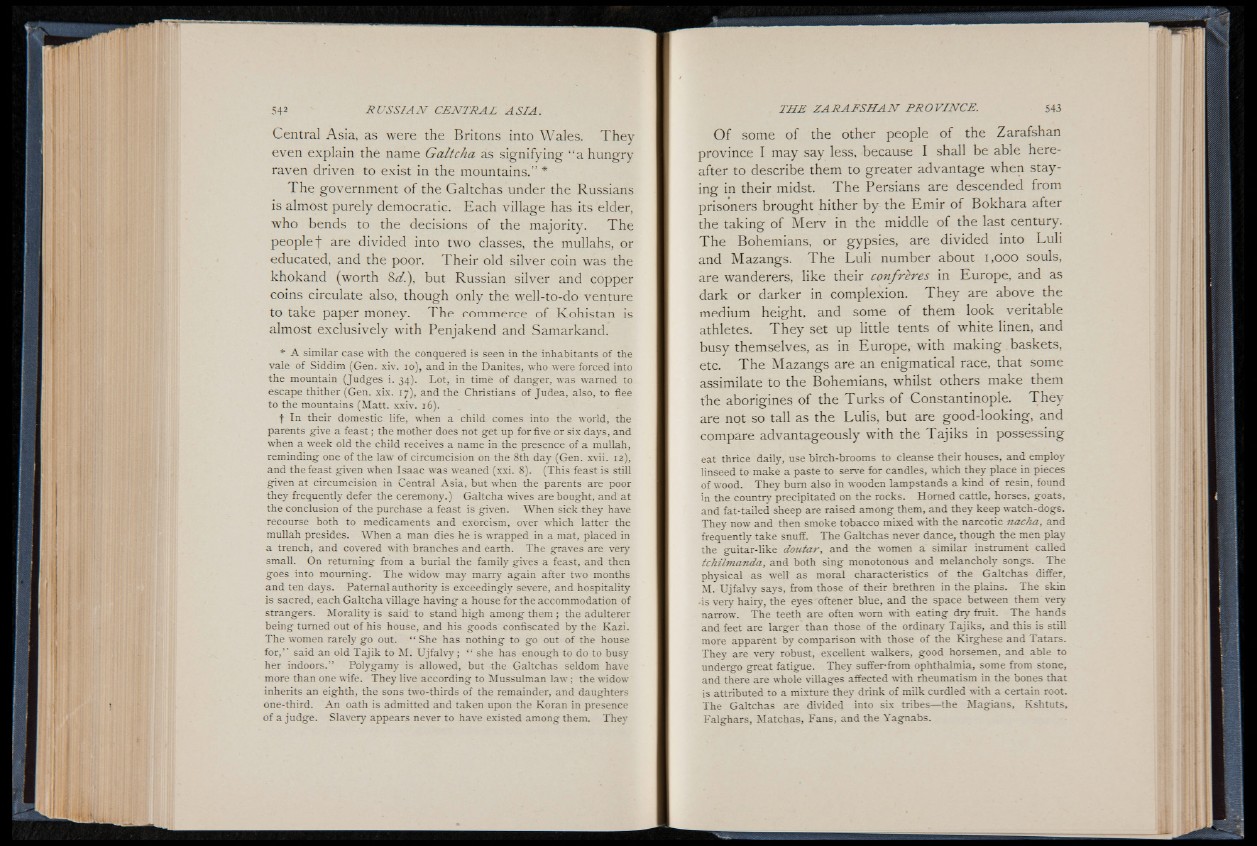
Central Asia, as were the Britons into Wales. They
even explain the name Galtcha as signifying “ a hungry
raven driven to exist in the mountains.” *
The government of the Galtchas under the Russians
is almost purely democratic. Each village has its elder,
who bends to the decisions of the majority. The
people f are divided into two classes, the mullahs, or
educated, and the poor. Their old silver coin was the
khokand (worth 8d.), but Russian silver and copper
coins circulate also, though only the well-to-do venture
to take paper money. The commerce of Kohistan is
almost exclusively with Penjakend and Samarkand.
* A similar case with the conquered is seen in the inhabitants of the
vale of Siddim (Gen. xiv. 10), and in the Danites, who were forced into
the mountain (Judges i. 34). Lot, in time of danger, was warned to
escape thither (Gen. xix. 17), and the Christians of Judea, also, to flee
to the mountains (Matt. xxiv. 16).
f In their domestic life, when a child comes into the world, the
parents give a fe a s t ; the mother does not get up for five or six days, and
when a week old the child receives a name in the presence of a mullah,
reminding one of the law o f circumcision on the 8th day (Gen. xvii. 12),
and the feast given when Isa ac was weaned (xxi. 8). (This feast is still
given at circumcision in Central Asia, but when the parents are poor
they frequently defer the ceremony.) Galtcha wives are bought, and at
the conclusion of the purchase a feast is given. When sick they have
recourse both to medicaments and exorcism, over which latter the
mullah presides. When a man dies he is wrapped in a mat, placed in
a trench, and covered with branches and earth. The graves are very
small. On returning from a burial the family gives a feast, and then
goes into mourning. The widow may many again after two months
and ten days. Paternal authority is exceedingly severe, and hospitality
is sacred, each Galtcha v illage having a house for the accommodation of
strangers. Morality is said to stand high among them ; the adulterer
being turned out of his house, and his goods confiscated by the Kazi.
The women rarely go out. “ She has nothing to go out of the house
for,’ ’ said an old T ajik to M. U jfa lv y ; “ she has enough to do to busy
her indoors.” Polygamy is allowed, but the Galtchas seldom have
more than one wife. They live according to Mussulman law ; the widow
inherits an eighth, the sons two-thirds of the remainder, and daughters
one-third. An oath is admitted and taken upon the Koran in presence
of a judge. Slavery appears never to have existed among them. They
O f some of the other people of the Zarafshan
province I may say less, because I shall be able hereafter
to describe them to greater advantage when staying
in their midst. The Persians are descended from
prisoners brought hither by the Emir of Bokhara after
the taking of Merv in the middle of the last century.
The Bohemians, or gypsies, are divided into Luli
and Mazangs. The Luli number about 1,000 souls,
are wanderers, like their confreres in Europe, and as
dark or darker in complexion. They are above the
medium height, and some of them look veritable
athletes. They set up little tents of white linen, and
busy themselves, as in Europe, with making baskets,
etc. The Mazangs are an enigmatical race, that some
assimilate to the Bohemians, whilst others make them
the aborigines of the Turks of Constantinople. They
are not so tall as the Lulis, but are good-looking, and
compare advantageously with the Tajiks in possessing
eat thrice daily, use birch-brooms to cleanse their houses, and employ
linseed to make a paste to serve for candles, which they place in pieces
of wood. They bum also in wooden lampstands a kind of resin, found
in the country precipitated on the rocks. Homed cattle, horses, goats,
and fat-tailed sheep are raised among them, and they keep watch-dogs.
They now and then smoke tobacco mixed with the narcotic nacha, and
frequently take snuff. The Galtchas never dance, though the men play
the guitar-like doutar, and the women a similar instrument called
tchilmanda, and both sing monotonous and melancholy songs. The
physical as well as moral characteristics of the Galtchas differ,
M. Ujfalvy says, from those of their brethren in the plains. The skin
-is very haiiy, the eyes oftener blue, and the space between them very
narrow. The teeth are often worn with eating dry fruit. The hands
and feet are larger than those of the ordinary T ajiks, and this is still
more apparent by comparison with those of the Kirghese and Tatars.
They are very robust, excellent walkers, good horsemen, and able to
undergo great fatigue. They suffer-from ophthalmia, some from stone,
and there are whole villages affected with rheumatism in the bones that
is attributed to a mixture they drink of milk curdled with a certain root.
The Galtchas are divided into six tribes— the Magians, Kshtuts,
Falghars, Matchas, Fans, and the Yagnabs.